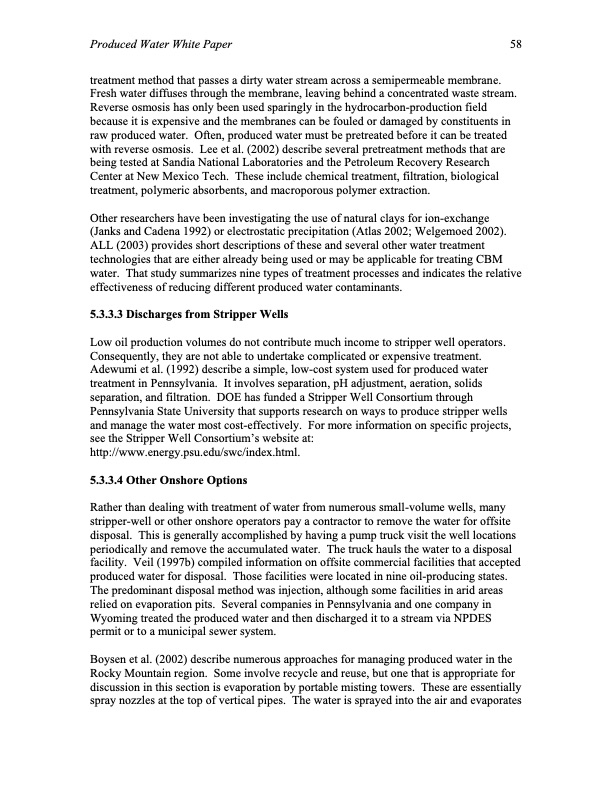
PDF Publication Title:
Text from PDF Page: 066
Produced Water White Paper 58 treatment method that passes a dirty water stream across a semipermeable membrane. Fresh water diffuses through the membrane, leaving behind a concentrated waste stream. Reverse osmosis has only been used sparingly in the hydrocarbon-production field because it is expensive and the membranes can be fouled or damaged by constituents in raw produced water. Often, produced water must be pretreated before it can be treated with reverse osmosis. Lee et al. (2002) describe several pretreatment methods that are being tested at Sandia National Laboratories and the Petroleum Recovery Research Center at New Mexico Tech. These include chemical treatment, filtration, biological treatment, polymeric absorbents, and macroporous polymer extraction. Other researchers have been investigating the use of natural clays for ion-exchange (Janks and Cadena 1992) or electrostatic precipitation (Atlas 2002; Welgemoed 2002). ALL (2003) provides short descriptions of these and several other water treatment technologies that are either already being used or may be applicable for treating CBM water. That study summarizes nine types of treatment processes and indicates the relative effectiveness of reducing different produced water contaminants. 5.3.3.3 Discharges from Stripper Wells Low oil production volumes do not contribute much income to stripper well operators. Consequently, they are not able to undertake complicated or expensive treatment. Adewumi et al. (1992) describe a simple, low-cost system used for produced water treatment in Pennsylvania. It involves separation, pH adjustment, aeration, solids separation, and filtration. DOE has funded a Stripper Well Consortium through Pennsylvania State University that supports research on ways to produce stripper wells and manage the water most cost-effectively. For more information on specific projects, see the Stripper Well Consortium’s website at: http://www.energy.psu.edu/swc/index.html. 5.3.3.4 Other Onshore Options Rather than dealing with treatment of water from numerous small-volume wells, many stripper-well or other onshore operators pay a contractor to remove the water for offsite disposal. This is generally accomplished by having a pump truck visit the well locations periodically and remove the accumulated water. The truck hauls the water to a disposal facility. Veil (1997b) compiled information on offsite commercial facilities that accepted produced water for disposal. Those facilities were located in nine oil-producing states. The predominant disposal method was injection, although some facilities in arid areas relied on evaporation pits. Several companies in Pennsylvania and one company in Wyoming treated the produced water and then discharged it to a stream via NPDES permit or to a municipal sewer system. Boysen et al. (2002) describe numerous approaches for managing produced water in the Rocky Mountain region. Some involve recycle and reuse, but one that is appropriate for discussion in this section is evaporation by portable misting towers. These are essentially spray nozzles at the top of vertical pipes. The water is sprayed into the air and evaporatesPDF Image | Produced Water from Production of Crude Oil

PDF Search Title:
Produced Water from Production of Crude OilOriginal File Name Searched:
ProducedWatersWP0401.pdfDIY PDF Search: Google It | Yahoo | Bing
NFT (Non Fungible Token): Buy our tech, design, development or system NFT and become part of our tech NFT network... More Info
IT XR Project Redstone NFT Available for Sale: NFT for high tech turbine design with one part 3D printed counter-rotating energy turbine. Be part of the future with this NFT. Can be bought and sold but only one design NFT exists. Royalties go to the developer (Infinity) to keep enhancing design and applications... More Info
Infinity Turbine IT XR Project Redstone Design: NFT for sale... NFT for high tech turbine design with one part 3D printed counter-rotating energy turbine. Includes all rights to this turbine design, including license for Fluid Handling Block I and II for the turbine assembly and housing. The NFT includes the blueprints (cad/cam), revenue streams, and all future development of the IT XR Project Redstone... More Info
Infinity Turbine ROT Radial Outflow Turbine 24 Design and Worldwide Rights: NFT for sale... NFT for the ROT 24 energy turbine. Be part of the future with this NFT. This design can be bought and sold but only one design NFT exists. You may manufacture the unit, or get the revenues from its sale from Infinity Turbine. Royalties go to the developer (Infinity) to keep enhancing design and applications... More Info
Infinity Supercritical CO2 10 Liter Extractor Design and Worldwide Rights: The Infinity Supercritical 10L CO2 extractor is for botanical oil extraction, which is rich in terpenes and can produce shelf ready full spectrum oil. With over 5 years of development, this industry leader mature extractor machine has been sold since 2015 and is part of many profitable businesses. The process can also be used for electrowinning, e-waste recycling, and lithium battery recycling, gold mining electronic wastes, precious metals. CO2 can also be used in a reverse fuel cell with nafion to make a gas-to-liquids fuel, such as methanol, ethanol and butanol or ethylene. Supercritical CO2 has also been used for treating nafion to make it more effective catalyst. This NFT is for the purchase of worldwide rights which includes the design. More Info
NFT (Non Fungible Token): Buy our tech, design, development or system NFT and become part of our tech NFT network... More Info
Infinity Turbine Products: Special for this month, any plans are $10,000 for complete Cad/Cam blueprints. License is for one build. Try before you buy a production license. May pay by Bitcoin or other Crypto. Products Page... More Info
| CONTACT TEL: 608-238-6001 Email: greg@infinityturbine.com | RSS | AMP |